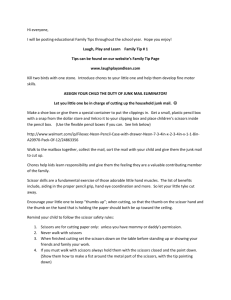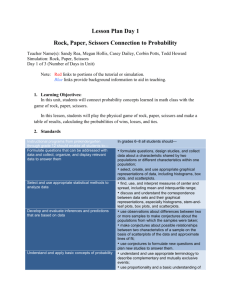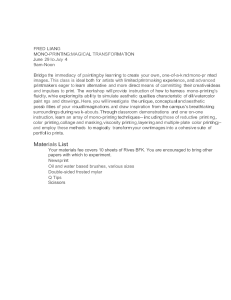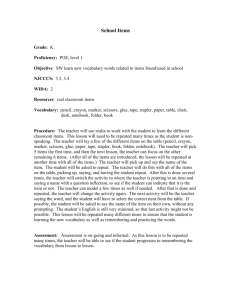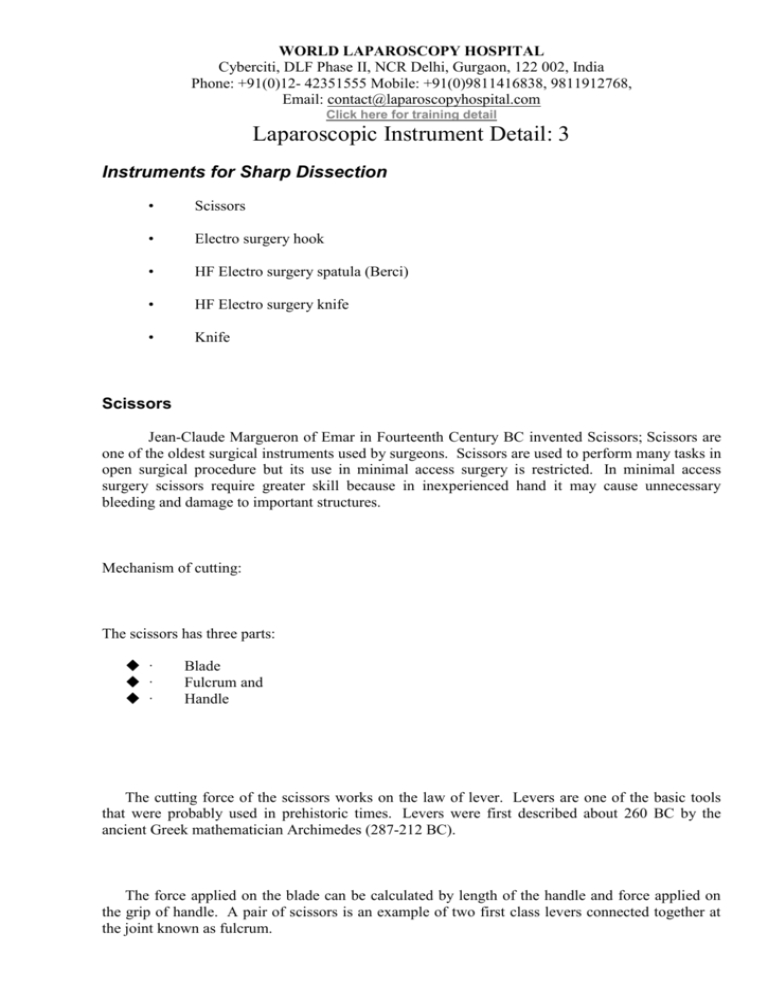
WORLD LAPAROSCOPY HOSPITAL
Cyberciti, DLF Phase II, NCR Delhi, Gurgaon, 122 002, India
Phone: +91(0)12- 42351555 Mobile: +91(0)9811416838, 9811912768,
Email: contact@laparoscopyhospital.com
Click here for training detail
Laparoscopic Instrument Detail: 3
Instruments for Sharp Dissection
•
Scissors
•
Electro surgery hook
•
HF Electro surgery spatula (Berci)
•
HF Electro surgery knife
•
Knife
Scissors
Jean-Claude Margueron of Emar in Fourteenth Century BC invented Scissors; Scissors are
one of the oldest surgical instruments used by surgeons. Scissors are used to perform many tasks in
open surgical procedure but its use in minimal access surgery is restricted. In minimal access
surgery scissors require greater skill because in inexperienced hand it may cause unnecessary
bleeding and damage to important structures.
Mechanism of cutting:
The scissors has three parts:
·
·
·
Blade
Fulcrum and
Handle
The cutting force of the scissors works on the law of lever. Levers are one of the basic tools
that were probably used in prehistoric times. Levers were first described about 260 BC by the
ancient Greek mathematician Archimedes (287-212 BC).
The force applied on the blade can be calculated by length of the handle and force applied on
the grip of handle. A pair of scissors is an example of two first class levers connected together at
the joint known as fulcrum.
There are three type of lever:
Scissors works on the principle of class 1 lever (two class 1 levers). In class 1 Lever, the
pivot (fulcrum) is between the effort and the load. The more the length of the handle or the fulcrum
of the scissors, the less force of cutting will be required. The laparoscopic scissors do not apply the
exact law of lever because of the cylinder action of the long shaft, but the design of handle helps in
the amplification of force by lever action.
Scissors function by the combination of:
1.
Gripping
2.
Squeezing and
3.
Tearing.
When the blades of scissors close, its sharp edges grind against each other and any tissue
which comes between the blades of scissors will get cut. The scissors-tissue interaction can be
described in five stages:
1. Engagement
In the process of engagement the two blades of the scissors engage a piece of tissue to cut. The
amount of tissue engaged should not be more than the space between the jaw of blades otherwise
the chance of slipping of tissue is more. After engagement, the force applied on the handle of the
scissors initiate cutting.
2. Elastic deformation
This stage starts just after the engagement of tissue between the blades of the scissors. In this
process, the tissues between the two blades of scissor start deforming. This stage is called elastic
deformation, because if the force on the handle of scissors is removed than the tissue deformity will
return to its normal state.
3. Plastic deformation
Further force on the handle of scissors will cause the tissue between the blades to go into a
plastic deformed state, which is irreversible. After undergoing this state of tissue deformation, even
if further process of cutting is stopped the impression on the tissue remains.
4. Fracture
Further increased force on the fulcrum of scissors will result in the fracture of intercellular
plane of the tissue. This stage of cutting is peculiar to scissors because unlike the scalpel the site of
tissue fracture is intercellular.
5. Separation.
After the fracture the tissue separates along line of the blade of scissors, and then this whole
process of cutting will continue on the engaged tissue.
Histology of the tissue after cutting:
Histological examination of the tissue after cutting with scissors shows that there is
separation of tissue through intra cellular plane. Microscopic examination shows serrated cut
margin along the line of tissue separation.
Types of Laparoscopic Scissors:
Straight scissors
The blade of this scissor is straight and it is widely used as an instrument for mechanical
dissection in laparoscopic surgery.
Curved Scissors
The blade of this scissors is slightly curved and this is the most widely used scissor in
laparoscopic surgery. These scissors are mounted on a curved handle which is either fixed or
retractable. The types with a fixed curvature proximal to the scissor blades require introduction
through flexible valve-less ports. The surgeon prefers this scissors because the curvature of the
blade of this scissors abolishes the angle of Laparoscopic Instruments manipulation and better view
through telescope.
Serrated scissors
The main advantage of this scissors is that the serrated edges prevent the tissue to slip out of
the blades. It is a useful instrument in cutting a slippery tissue or ligature.
Hook Scissors
The sharp edge of both blades is in the shape of a flattened C. The blades can be partially
closed trapping tissue in the hollow of the blades without dividing it and allowing it to be slightly
retracted. This allows the surgeon to double check before he closes the blades completely.
The main advantage of this scissors is that, it encircles the structure before cutting: Tissue is
held between its jaws and there is no chance of slipping. The Hook scissor is especially useful for
cutting secured duct or artery in laparoscopic surgery. The cutting of nerve bundle in neurectomy
becomes very easy with the help of this scissors. Hook scissors is also helpful in partial cutting of
cystic duct for intra-operative Cholangiography.
Micro tip scissors
These very fine scissors, are either straight or angled, and are used to partially transect the
cystic duct. The main advantage of this scissors is to cut the ducts partially for facilitating
cannulation. This scissor may be used for cutting the cystic duct for performing intra-operative
Cholangiogram. Exploration of small ducts like common bile duct is very helpful with micro
scissors due to its fine small blades. Fine micro scissors are also available in its curved form.
The use of scissors endoscopically requires little modification of open techniques. The basic
instrument is a miniaturized, long handled version of conventional scissors and can be single or
double action. There are some special types of scissors used in endoscopic surgery:
Insulated scissors
These allow the use of electrocautery through the scissors. However when using nondisposable instruments, electro coagulation using the open blades leads to blunting of the edges.
Electro coagulation using the scissors is thus limited in this unit, and when carried out is applied
only with the blades closed. Scissor dissection is usually carried out with a grasper in the other
hand to tension the tissues. If this instrument is insulated then any vessels encountered can be easily
coagulated by the grasper. A further disadvantage associated with electro coagulation with the
scissors results from the long non-insulated segment required to accommodate the blades and hinge
mechanism. For safe practice this requires to be kept in view and this limits the magnification
available to the surgeon.
Scissors has following advantages:
1.
Inexpensive
2. Safe in safe hand
3. Operator determined précised action
4. Closed blades, can work for blunt dissection and electrocautery
5. Piercing tissue with closed blades and then opening helps in obtaining a good plane of
dissection.
Scissors has following disadvantages:
1.
Non haemostatic
2.
Accidental chances of cutting small ducts and vessels
3.
Due to its pointed end, if overlooked there is chance of injury to viscera
4.
If used for electric coagulation its blades get blunt easily.
Endo-knife (scalpel)
The knife is not used frequently in endoscopic surgery due to the problems associated with the
safety of a blade, which cannot be closed or deactivated. However it does have some important
uses;
In our practice a disposable blade (Beaver) is mounted on a metal rod, which has a socket at the
distal end into which it can be screwed.
The most common use of the knife is for opening the hepatic duct or common bile duct during
exploration for stones. A small, clean cut, linear stab wound is created in the anterior wall. Great
care is required during incision and removal of the knife. However a sharp curved scissors is better
and safer than the endoknife for the choledochotomy.
Biopsy Forceps
Punch, Cutting and Dissecting biopsy forceps are used to take biopsies at the time of laparoscopic
surgery. The toothed punch biopsy forceps has special teeth which prevent accidental drop of tissue
inside the abdominal cavity.
Coagulating and Dissecting Electrodes
Spatula and hook is the main electrode used for monopolar cutting and coagulation.
Spatula is either “W” shaped or Blunt. Hooks are also of various shapes eg; “L” shaped, “J” shaped
or “U” shaped.
Some ball shaped, Barrel shaped or straight coagulation electrodes are also available to achieve
proper haemostatis. These blunt electrodes are particularly useful when there is generalized oozing
of blood and surgeon can not see specific bleeder point eg; bleeding from the gallbladder bed at the
time of laparoscopic cholecystectomy. These blunt electrosurgical instruments are also used for
fulguration at the time of ablation of endometriosis.
Bipolar Forceps
Bipolar forceps are one of the very important electrosurgical instruments in minimal access
surgery. It is safe compare to monopolar current because electron travels only through the tissue
held between the jaw and patient body is not a part of circuit. Both the jaw of bipolar is insulated
and the patient return plate is not necessary to be attached. The detail principle of electrosurgery is
discussed in chapter of laparoscopic dissection techniques of this book.
Aspiration Needle
These lo needle is used in laparoscopy to aspirate fluid from distended ovarian cysts, gall bladder,
or any localized pocket of pus in liver. It may be used for drilling of polycystic ovary. Aspiration
needle should be inserted inside the abdominal cavity with extreme precaution because if the
pathway of entry or exit is ignored it can cause perforation of viscera.
Fan retractor
These retractors are used to retract Liver, Stomach, Spleen or bowel whenever they interfere in
vision or they come in way of other working instrument. There are many newer variety of retractors
are available now a days which are less traumatic. Cuschieri liver retractor is one of them which is
very useful in Fundoplication.
This liver retractor has a distal end which can be rotated by moving handle. Retractor is introduced
in abdominal cavity when it is straight. Once it is inside the abdomen the distal end can take various
shapes just like serpent. This retractor can also be used for simple, atraumatic manipulation of
bowel.
Needle holders
If surgeon or gynaecologist wants to perform any advance laparoscopic procedure they should
develop art of laparoscopic suturing and knotting. Laparoscopic knotting and suturing should be
learnt on a good quality endotrainer. The art and science of laparoscopic suturing and knotting is
explained in chapter of tissue approximation technique of this book. Surgeon should slowly
expertise these techniques. They will develop their confidence once they are capable of suture
inside abdominal cavity and there conversion rate will also decrease.
Many automatic laparoscopic suturing devices are invented for intracorporeal suturing but none of
them are substitute of manual laparoscopic suturing because these devices can work only under
appropriate tissue plane suitable for there application.
Knot Pusher
Although pre-tied loops are available in the market but surgeon should learn how to tie these
extracorporeal knot.
Pre-tied loop can be used for any free structure like appendix but for continuous structure like
cystic duct surgeon has to perform extracorporeal knotting intra-operatively. For Extracorporeal
Knotting knot pushers are used. These knot pushers are of either closed jaw or of open jaw type.
Laparoscopic clip applicator
Titaneum is most widely used metal in minimal access surgery for tissue approximation. It rarely
reacts with human body and this is one of the good properties why it is so popular. It is easy to
apply and can be left inside abdominal cavity. After few weeks it is covered by fibrous tissue.
Titaneum clip is used by 99% of surgeons for clipping cystic duct and cystic artery at the time of
laparoscopic cholecystectomy. Recently newer silicon clips has been launched.
The jaw of clip applicator should be at right angle to the structure and before clipping surgeon
should take care that both the jaw is seen. If one of the jaws is hidden there is always a possibility
that some tissue will get entrapped between the jaw of clip and clip will be loose. At the time of
securing any duct or artery with titanium clip, three clips are generally applied. Two clips are left
towards the structure which is secured and one clip is towards the tissue which surgeon wants to
remove to prevent spillage of fluid. The distance between first and second clip should be 3mm and
distance between second and third clip should be 6mm so that after cutting in between second and
third clip there will be 3 mm stump both the side. The clip should not be applied very near to each
other, because clips are held in position by dumbbell formation and if they are very near to each
other they will nullify the dumbbell formation of each other and both the clip will be loose.
Cystic duct clip stone
Recently many cases have been reported of cystic duct clip stone and this is the reason why in
many institutions clipping of cystic duct is replaced by extracorporeal knotting. If titanium clip is
applied on the cystic duct sometime it may crush one of the walls of cystic duct and it may get
internalized inside the lumen of cystic duct. Inside the lumen of cystic duct it acts as a niddus for
the deposition of bile pigment and then formation of stone. After cross section of these stone the
clip inside is seen glistening like pupil of a cat and so it is also known as “Cat eye stone”. These
stone can slip inside the CBD and it may cause CBD obstruction. Although the reported case of
CBD obstruction is very less the surgeon should try to ligate cystic duct to avoid this complication.
Irrigation and Suction tube
Laparoscopic suction and irrigation tube is one of the very important instruments which surgeon
should practice frequently. Vision is one of the limitations of laparoscopic surgery. The blood is the
darkest colour inside abdominal cavity and excess of blood inside absorbs most of the light.
Whenever there is bleeding inside one should first try to suck it out. Suction irrigation tube also can
be used for blunt dissection. At the time of using suction and irrigation the tip of the suction
irrigation cannula should be dipped inside blood otherwise the gas will be sucked and surgeon will
loss his vision due to loss of pneumoperitoneum. 10 mm suction tube should be used if there is
more than 1500ml of hemoperitoneum or if there is blood clots inside the abdominal cavity.
Sometime small spilled stones can also be sucked with the help of laparoscopic irrigation suction
tube at the time of laparoscopic cholecystectomy.
Fallop ring applicator
Fallop ring applicator is used for application of silastic ring to perform tubeligation. These may be
fitted with one or two silastic rings.
Myoma Fixation screw
This is used to fix the sub serous or intramural myoma at the time of laparoscopic myomectomy.
Uterine manipulator
Uterine manipulator is one of the very essential instruments for mobilization of the uterus,
identification of the vaginal fornices and sealing of the vagina during hysterectomy. Uterine
manipulator is used in most of the advance gynaecological procedures.
For More Information Contact:
Laparoscopy Hospital
Unit of Shanti Hospital, 8/10 Tilak Nagar, New Delhi, 110018. India.
Phone:
+91(0)11- 25155202
+91(0)9811416838, 9811912768
Email: contact@laparoscopyhospital.com
Copyright © 2001 [Laparoscopyhospital.com]. All rights reserved.
Revised:
.

